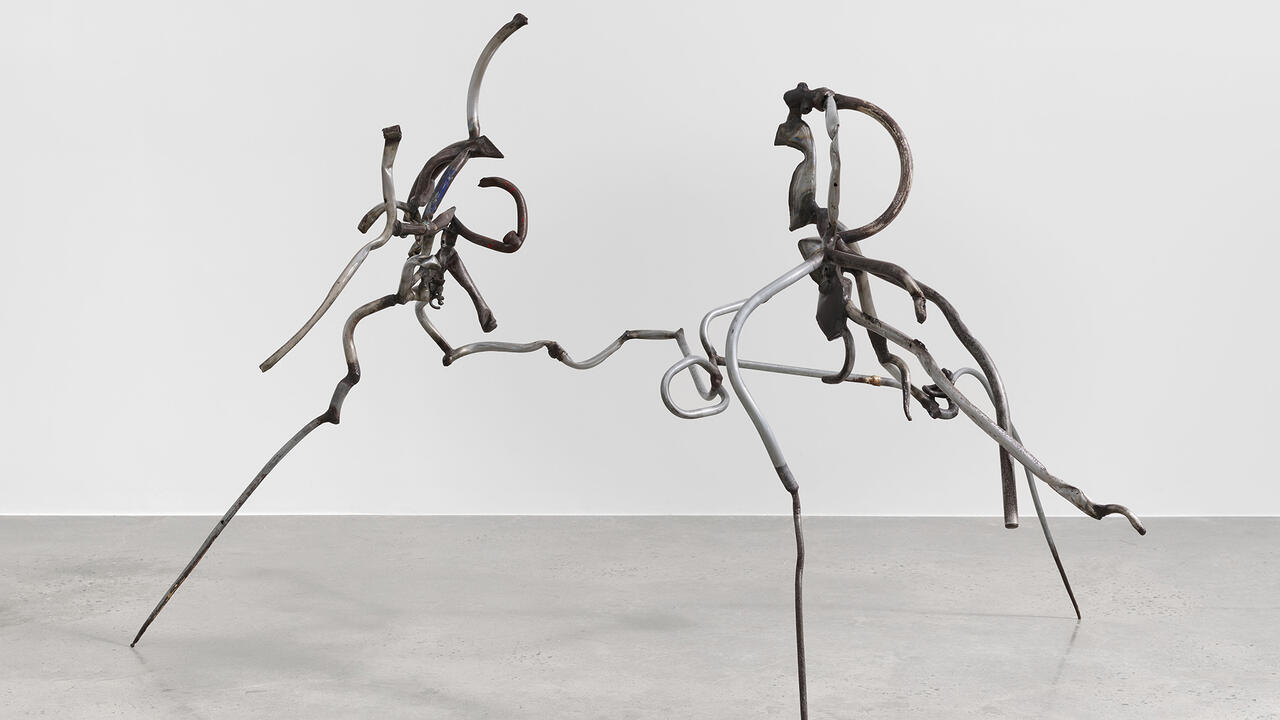Luc Tuymans Retrospective at Palazzo Grassi, Venice
More than 80 works from four decades mine the tension between beauty and horror
More than 80 works from four decades mine the tension between beauty and horror

It’s easy to miss Schwarzheide (2019), the newest work in Luc Tuymans’s four-decade retrospective ‘La Pelle’ at Palazzo Grassi; in fact, when I attended the exhibition on its first public day, some visitors were walking all over it. Later, coming across the work’s label installed on the floor above, then looking down at the marbled mosaic floor of the Palazzo’s atrium, an image of dark pines becomes clear. The trees appear disparate against the white background, yet somehow connected, like suspects in a police line-up.
Tuymans based the piece, as well as a 1986 painting of the same title, on a drawing by Alfred Kantor, a survivor of the Schwarzheide Nazi labour camp, which depicts the evergreens that kept the camp out of locals’ sight. To hide paper notes and sketches from Nazi guards, prisoners would cut them into strips to be pieced together later. Thin, black vertical lines in Tuymans’s mosaic signal a solemn act of reassembling.

The painting Twenty Seventeen (2017), installed on the Palazzo’s upper level, shows a pale, emaciated yet well-made-up face frozen in a wide-eyed expression of fear and harshly lit, as if caught by a searchlight. A text explains that the work takes its inspiration from the Brazilian television series 3% (2016–ongoing), in whose nightmarish dystopia the poor entertain the rich in a Hunger Games-style battle for their lives, with a contestant’s chances of survival standing at just three percent.
This haunting image is a clever choice for the exhibition poster: it conveys not only Tuymans’s unique style of fuzzy figuration, tinged by an instinct for the unnerving, but also his tool box. Basing his oil paintings on found images, newspaper clippings, smartphone snaps and photographs of photographs, the Belgian artist distils a source image to a few essential kernels. He then renders these core elements so crystal clear that they have the faculty to reflect: our projections, assumptions, desires, fears.

Two paintings in the show of more than 80 works, both titled Issei Sagawa, depict the titular Japanese man convicted of the murder and cannibalization of a fellow student at the Sorbonne University in Paris in 1981. Installed on two different floors, in reverse chronological order, they’re both part of Tuymans’s series of quickly rendered portraits of perpetrators of violent acts. The first, from 2014, shows a narrow-shouldered figure with deformed ghostly features peering back at the viewer from beneath the shadow cast by an oversized colonial hat, tilted to one side. It’s a painting of a smartphone capture of a photograph shown in a documentary about the killer. The image, which shows Sagawa wearing a mask, was taken several years before the crime occurred. The second, from 2012, is based on material snapped from the same film. An outline of a bespectacled man pushes against the frame, his blurry features hardly discernible, so regular looking that he simply blends into the background.

It’s in the palpable tension between beauty and horror – which is expertly sustained throughout this stunning show, which was curated by Caroline Bourgeois with the artist – that Tuymans’s central question about the nature of representation finds its clearest expression. By diffracting and sublimating in paint the images that saturate our everyday lives, Tuymans asks us to consider whether it is ever really possible to portray reality.
Body (1990) is one of the smallest canvases in the show, measuring just 49 x 39 cm. It depicts an awkwardly outlined torso of a rag doll, with two simple black lines to indicate the zips through which the toy could be restuffed. The neck and legs are cut out of the frame, the arms only partially visible. The work is a dirty, cracked white. Tuymans chose a paint that would change over time, to reflect its ageing. Nothing is what it seems. Death, here, is the only given.
‘La Pelle – Luc Tuymans’ runs at Palazzo Grassi, Venice, until 6 January 2020.
Main image: Luc Tuymans, Secrets, 1990, installation view at Palazzo Grassi, 2019. Courtesy: the artist, Courtesy Zeno X Gallery, Antwerp and Palazzo Grassi, Venice; photograph: Delfino Sisto Legnani and Marco Cappelletti.





















